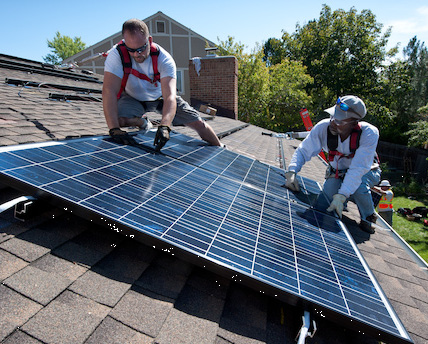The Obama administration has just announced a new initiative to “increase access to solar energy for all Americans, in particular low- and moderate- income communities, while expanding opportunities to join the solar workforce.” Here are five reasons why this effort matters.
It’s needed
More than 600,000 American roofs now sport solar panels, and many other households and companies are getting their piece of the action through shared solar approaches. So it’s clear that solar has spread far from its roots as a space-age technology.
But it’s also clear that we want to do much more, including for broadening solar’s reach. A large swath of Americans can’t do solar on their own homes yet, because they don’t have a sufficiently sunny roof, or because they don’t have the money or the credit, they rent, or they live in a multi-family.

It’s working
The new initiative tackles some important pieces of the challenge of expanding access. The announcement includes a host of stats about solar’s impressive performance in recent years, about the pace of solar installations (every 3 weeks last year saw as much new solar as in all of 2008), about job creation (“the solar industry added jobs 10 times faster than the rest of the economy”), and price drops (50% since 2010).
It also includes some data about one piece in particular: the earlier goal that the administration had set of 100 megawatts (MW) of solar on federally subsidized housing by 2020. It turns out that we’ve blown past that particular target, at least in terms of commitments. (Solar has made a habit of blowing past even lofty goals in recent years—just ask Massachusetts).
So this initiative includes a new goal of 300 MW for such housing by 2020. That tripling reflects not just where the technology has been going but what so many organizations and companies are succeeding in doing to spread solar’s reach.
It’s broad
And this initiative proposes to do its work not just through the federal government, but with an impressive array of partnerships.
Federal agencies involved range from the Department of Housing and Urban Development to AmeriCorps to national laboratories. And partners include non-profits, solar companies and industry groups, and state and local governments, from departments of environmental protection and economic development to housing authorities. Even NASCAR is joining the fun.

Photo: National Renewable Energy Laboratory
That kind of breadth—with more than 20 states and hundreds of projects—will help make sure not just that the people and organizations directly affected move forward on solar, but that there will be dozens, or hundreds, of “laboratories” for testing new ideas and new approaches for expanding solar’s reach.
It’s not just about the money
The announcement includes important information about money being brought to bear on this issue, including more than half a billion dollars to “advance community solar or scale up solar and energy efficiency in low- and moderate- income communities.”
But, importantly, this effort isn’t just about money. It also includes:
- Streamlining – One piece is about making it easier to use Federal Housing Authority money to fund solar.
- Technical assistance – Another piece will provide “direct technical assistance to affordable housing organizations” participating in this push.
- Workers and jobs – The initiative builds on the administration’s earlier pushes around training would-be solar workers, including former soldiers, and includes a push by the solar industry, the administration says, around a “goal of becoming the most diverse sector of the U.S. energy industry.”
- Information – Good information about how to go solar—for low-income households or companies or governments looking to serve them—is another key piece, including a handy guide on community solar and information and resources for homebuilders who want to do solar.
We need to (and can) do more
One recent piece of context is last week’s U.S.-Brazil agreement on climate/energy action. The U.S. announced its commitment to get 20% of our electricity from non-hydro renewables by 2030. That’s important, make no mistake.
But we can do more. Analyses from UCS and others show what’s possible in that regard. Under the Clean Power Plan, for example, we found that, even with conservative assumptions, it’s easy to envision 23% renewables by 2030. And our new analysis of a 30%-by-2030 renewable electricity standard shows that level of renewables is feasible, good for consumers, and good for cutting carbon.
Going beyond
The moves announced today are what the administration and partners across the country can make happen. We need Congress to get in the act too, though, with legislation to directly tackle solar access issues or drive the development of renewable energy more broadly.
Today’s announcement is worth applauding. And it’s worth building on to make sure we—all of us—move down the clean energy path, as quickly as possible.
